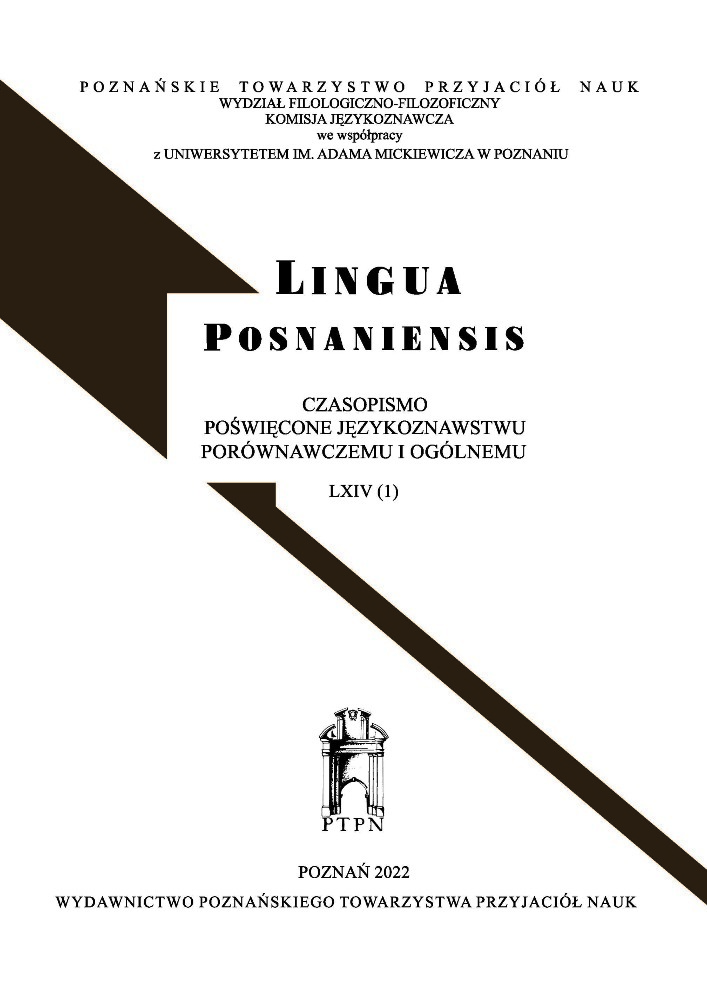Abstract
This contribution analyzes the geographical name Θούλη, first recorded by Pytheas of Massalia in the period 330-325 BCE and mediated especially by Polybius, Strabo, Pliny and Procopius. Björn Collinder (1935/1936) designated this term as the earliest datable document of the Germanic Lautverschiebung. He also offered an appealing etymology, explaing the toponym on the basis of Old Norse þaularvágr “winding creek”, i.e. a place especially characteristic of the West Norwegian coast with its winding fjords. In the present study an alternative etymology by Torp is also analyzed, interpreting the toponym as a wooded place with regard to Old Norse þollr m. “tree, fir-tree, pine-tree”, and the witness of Procopius of Caesarea on the exceedingly large forests in Thule [‘The Gothic War’ VI.15]. Independently of whether either of the solutions of Collinder or Torp is correct, around 330 BCE the First Germanic Sound Shift should already have been operating.
References
Beekes, R., with assistance of Lucien van Beek. 2010. Etymological dictionary of Greek. Vols. I-II. Leiden, Boston: Brill.
de Bernardo Stempel, P. 1987. Die Vertretung der indogermanischen liquiden und nasalen Sonanten im Keltischen (Innsbrucker Beiträge zur Sprachwissenschaft 54). Innsbruck: Universität Innsbruck.
Clark Hall, J.R. 1916. A concise Anglo-Saxon dictionary. New York: The MacMillan Company.
Collinder, B. 1935. Der älteste überlieferte germanische Name. In Nomina Germanica: Hyllningsskrift till Bengt Ivar Hesselman den 21 december 1935, 92-97. Lund: Lundequistska bokhandeln (= Namn och bygd 24, 1936, 92-97).
Delamarre, X. 2018. Dictionnaire de la langue gauloise.3 Paris: Errance.
DIL = Dictionary of the Irish language. 1998. Dublin: Royal Irish Academy (Compact Edition).
ESJS = Havlová, E. et alii (eds.). 1989f. Etymologický slovník jazyka staroslověnského. Praha: Academia – Brno: Tribun EU.
EWAhd II = Lloyd, A.L. & Lühr, R. & Springer, O. & Purdy, K.R. 1998. Etymologisches Wörterbuch des Althochdeutschen, Bd. II: bî – ezzo. Göttingen – Zürich: Vandenhoeck & Ruprecht.
Hamp, E.P. 1989. Prehellenica. 8. Thule, Thyle. Živa antika 39. 84.
Holthausen, F. 1963. Altenglisches Etymologisches Wörterbuch.2 Heidelberg: Winter.
Korolev, A.A. 1984. Drevnejšie pamjatniki irlandskogo jazyka. Moskva: Nauka.
LEIA = Vendryes, J. (par les soins de E. Bachellery et P.-Y. Lambert). 1978. Lexique étymologique de l’irlandais ancien (T-U). Dublin: Institute for Advanced Studies – Paris: CNRS Éditions.
LGLO III = Hahmo, S.-L. & Hofstra, T. & Nikkilä, O. 2012. Lexikon der älteren germanischen Lehnwörter in den ostseefinnischen Sprachen, Bd. II: K-O. Amsterdam & Atlanta: Rodopi. DOI: https://doi.org/10.33339/fuf.85757
LIV = Rix, H. (ed.) & Kümmel, M. & Zehnder, T. & Lipp, R. & Schirmer, B. 2001. Lexikon der indogermanischen Verben2. Wiesbaden: Reichert.
Machek, V. 1968. Etymologický slovník jazyka českého.2 Praha: Academia.
Malášková, Z. & Blažek, V. 2012 [2016]. On the position of Frisian within the West Germanic continuum. Philologia Fenno-Ugrica et Indoeuropaea (Zeitschrift für finnisch-ugrische Philologie, indoeuropäische und diachrone Linguistik) 18. 1-23.
Matasović, R. 2009. Etymological dictionary of Proto-Celtic. Leiden – Boston: Brill.
Meyer-Lübke, W. 1935. Romanisches etymologisches Wörterbuch. Heidelberg: Winter.
Much, R. 1918-1919. Taunus. In Hoops, J. (ed.), Reallexikon der germanischen Altertumskunde. 4. Bd. (Rü-Z). Ed. by J. Hoops. Strassburg: Trübner.
Much, R. 1925. Der Eintritt der Germanen in die Weltgeschichte. In Germanistische Forschungen. Festschrift anläßlich des 60-semestrigen Stiftungsfestes des Wiener Akademischen Germanistenvereins, 8-66. Wien: Österreichischer Bundesverlag.
Nansen, F. 1911. In northern mists: Arctic exploration in early times. Vol. I. Transl. A.G. Chater. New York: Frederick A. Stokes.
Noreen, A. 1920. Nordens älsta folk- och ortnamn. Fornvännen 15. 23-50.
Pedersen, H. 1909. Vergleichende Grammatik der keltischen Sprachen. Vol. I. Göttingen: Vandenhoeck & Ruprecht.
Pokorny, J. 1959. Indogermanisches etymologisches Wörterbuch. Bern – München: Francke.
Procopius. 1919. History of the wars. Transl. H.B. Dewing. London: Heinemann – New York: Putnam’s Sons.
Pronk, Tijmen. 2015. Singulative n-stems in Indo-European. Transactions of the Philological Society 113(3). 327-348. DOI: https://doi.org/10.1111/1467-968X.12058
{Claudii} Ptolemaei Geographia. 1966. Nobbe, C.F.A. (ed.). Hildesheim: Olms.
Ptolemy, C. 1932 (repr. 1991). The Geography. Transl. and ed. E.L. Stevenson. New York: The New York Public Library.
Qvigstad, J.K. 1893. Nordische Lehnwörter im Lappischen (Christiania Videnskabs-Selskabs Forhandlinger for 1893, No. 1). Christiania: Dybwad.
Sims-Williams, P. 2003. The Celtic inscriptions of Britain: Phonology and chronology, c. 400-1200 (Publications of the Philological Society, 37). Oxford – Boston: Blackwell.
Turner, R.L. 1966, 1969, 1985. A comparative dictionary of the Indo-Aryan languages, plus Indexes, plus Addenda and corrigenda (ed. J.C. Wright). London – New York – Toronto: Oxford University Press – London: School of Oriental and African Studies.
de Vaan, M. 2008. Etymological dictionary of Latin and the other Italic languages. Leiden – Boston: Brill.
de Vries, J. 1962. Altnordisches etymologisches Wörterbuch.2 Leiden: Brill.
Walde, A. & Hofmann, J.B. 1954. Lateinisches etymologisches Wörterbuch. Vol. II. Heidelberg: Winter.
Zair, N. 2013. The reflexes of the Proto-Indo-European laryngeals in Celtic. Leiden – Boston: Brill. DOI: https://doi.org/10.1163/9789004233096
License
Copyright (c) 2023 Václav Blažek

This work is licensed under a Creative Commons Attribution-NonCommercial-NoDerivatives 4.0 International License.

